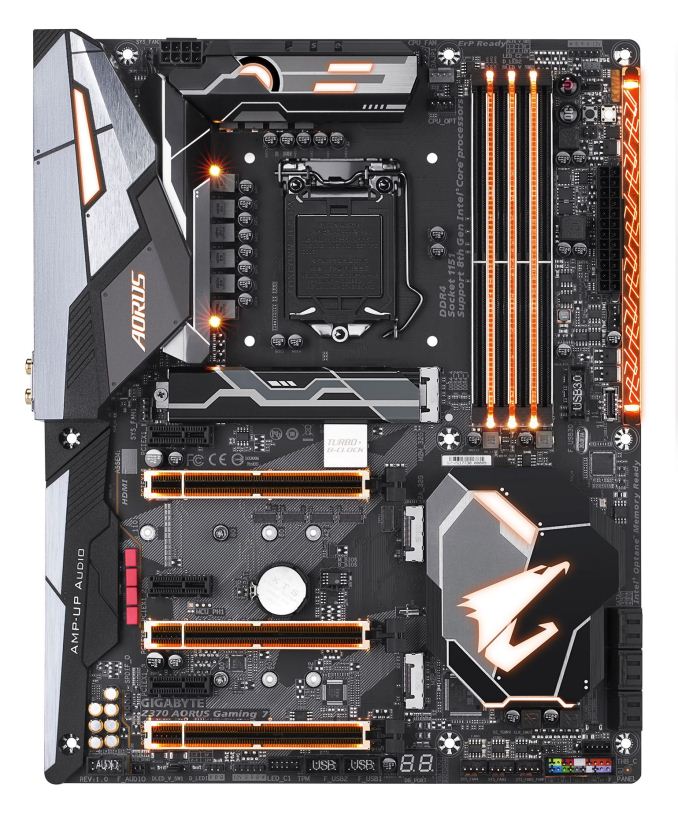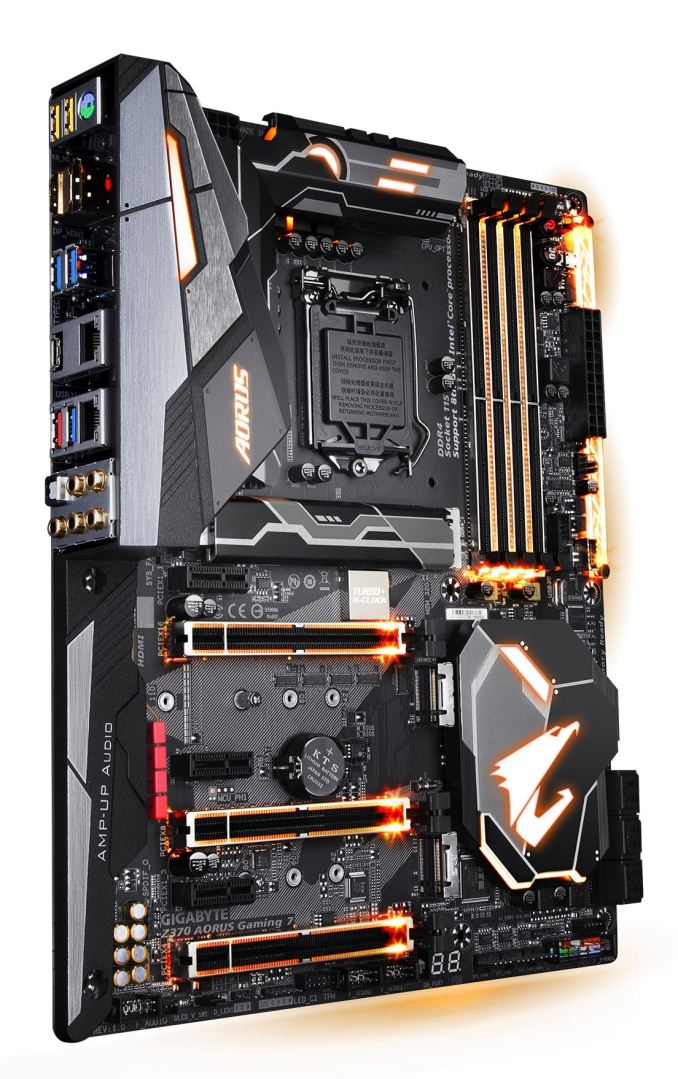Analyzing Z370 for Intel's 8th Generation Coffee Lake: A Quick Look at 50+ Motherboards
by Ian Cutress, Anton Shilov, Joe Shields & Gavin Bonshor on October 20, 2017 2:00 PM ESTGIGABYTE AORUS is starting off its entrance into the Z370 chipset with a total of nine offerings. The 'entry level' Ultra Durable lineup has three boards: the Z370XP SLI, HD3P, and HD3. The AORUS Gaming lineup has the other six boards, offering more features and glamor than the UD boards. From the flagship down there is the Gaming 7, Gaming 5, Ultra Gaming, Gaming 3, Gaming K3, and Gaming Wi-Fi. Each board will offer slightly features from a different VRM section, the number of M.2 connections, USB, networking, audio codecs, and more.
GIGABYTE Z370 Gaming 7
The AORUS Gaming 7 looks to be the brightest (literally) board of the bunch with RGB LEDs found in several places on the board: the IO cover, the VRM heatsink, by the VRMs on the board, between the DIMM slots, on the PCIe slots, the PCH heatsink, and finally, an aesthetic strip on the right side by the 24-pin ATX connector.
All of the full-length PCIe slots have steel reinforcement to prevent slot damage against heavy video cards. The Gaming 7 is the only board in the lineup to add power/reset and overclocking buttons on the PCB which are located in the upper right-hand corner. The Gaming 7 uses different chokes for the VRM from Coiltronics (FP 1007) - from the pictures provided, we are unable to tell if the MOSFETs or controller is different to the Gaming 5. For more BCLK range and flexibility for overclocking, there is a BCLK generator under the EMI shield between the top M.2 and PCIe slots.
The Gaming 7 uses of four reinforced DIMM slots with RGB LEDs in between. capable of up to 64GB of system memory. The supported memory speeds for the Gaming 7 (and Gaming 5) are the highest in the GIGABYTE lineup at DDR4-4133. The other boards will top out at DDR4-4000 by comparison. The PCIe slot locations allow for triple wide video cards to be used in a Dual GPU setup and are wired in an x16/x8/x4 configuration with the last slot powered by the chipset, meaning two-way SLI and three-way Crossfire are supported. PCIe x1 slots are located above the first, second, and last full-length PCIe slots and are fed from the chipset. The last PCIe slot shares bandwidth with the M2P_32G and will operate at up to 2x mode when using a PCIe SSD in that specific slot.
For SATA storage, we will see a pretty familiar theme across the entire lineup as each board will have six SATA ports. In the case of the Gaming 7, they are located to the right of the chipset heatsink and set at a right angle to the board. The three M.2 slots can be found just above the first PCIe x1 slot, below the first full-length slot, as well as the second. The top M.2 slot comes with a heatsink and will fit up to a 110mm device, while the other two slots support up to 80mm drives and do not come with a heatsink.
For users that connect chassis and system fans to the board directly, the Gaming 7 has a total of eight fan headers: the CPU fan and CPU_Opt are located by the socket between the DIMM slots and the VRM heatsink; Across the bottom are three system fan headers with a fourth hiding at the end of the top M.2 slot behind the rear I/O audio; the eighth fan header is located in the top right corner of the board. All headers are hybrid and can be controlled by PWM or voltage using the RGB Fusion software.
Audio is driven by the Realtek ALC1220 codec and uses an ESS Sabre DAC, Nichicon caps, and WIMA audio caps in an effort to improve headphone output. The Gaming 7 has dual NICs, using the Rivet Networks Killer E2500 controller alongside the Intel I219V. There is no Wi-Fi, which is perhaps an interesting omission on a flagship board - however the Gaming 5 does have WiFi. Thunderbolt 3 connectivity is maintained on the Gaming 7 with the header located in the bottom right-hand corner above the front panel headers.
USB support is a bit different here than the other GIGABYTE boards. The Gaming 7 has USB3.1 (10 Gbps) Type-C and Type-A headers on the rear I/O but also add a Type-C header for the front. USB3.1 (5 Gbps) shows a header for the front and five ports on the rear. The rear I/O is a bit more sparse without Wi-Fi, but it still includes Displayport and HDMI outputs for video, the two NICs, five USB 5 Gbps Type-A ports, and the two USB 3.1 (10 Gbps) ports (Type-A and Type-C).
The Gaming 7 comes with everything most users need including a lot of RGB LEDs and adds features such as a reinforced third PCIe slot, a Killer E2500 NIC, onboard Power/Reset/OC buttons, and improved headphone audio. About the only thing missing is Wi-Fi which could also be added via an add-in card.
| GIGABYTE Z370 AORUS Gaming 7 | |
| Warranty Period | 3 Years |
| Product Page | Link |
| Price | Amazon US |
| Size | ATX |
| CPU Interface | LGA1151 |
| Chipset | Intel Z370 Express |
| Memory Slots (DDR4) | Four DDR4 Supporting 64GB Dual Channel Support DDR4 4133+ Support for ECC UDIMM (operates in non-ECC mode) |
| Network Connectivity | 1 x Rivet Networks Killer E2500 LAN 1 x Intel GbE LAN |
| Onboard Audio | Realtek ALC1220 |
| PCIe Slots for Graphics (from CPU) | 1 x PCIe 3.0 x16 slots @ x16 or x8 1 x PCIe 3.0 x16 slots @ x8 |
| PCIe Slots for Other (from Chipset) | 1 x PCIe 3.0 x16 slots @ x4 3 x PCIe 3.0 x1 slots @ x1 |
| Onboard SATA | 6 x Supporting RAID 0/1/5/10 |
| Onboard SATA Express | None |
| Onboard M.2 | 3 x PCIe 3.0 x4 - NVMe or SATA |
| Onboard U.2 | None |
| USB 3.1 (10 Gbps) | 1 x Type-C (ASMedia) 1 x Type-A (ASMedia) 1 x Type-C (ASMedia - through internal header) |
| USB 3.1 (5 Gbps) aka USB 3.0 |
5 x Back Panel 1 x Header |
| USB 2.0 | 2 x Headers |
| Power Connectors | 1 x 24-pin EATX 1 x 8-pin ATX 12V 1 x 4-pin ATX 12V |
| Fan Headers | 1 x CPU 1 x Watercooling CPU 5 x System Fan headers 1 x 3A System Fan/ Water Pump header |
| IO Panel | 1 x PS.2 keyboard/mouse port 1 x DisplayPort 1 x HDMI Port 5 x USB 3.1 ports 1 x USB 3.1 Type-C 1 x USB 3.1 Type-A 2 x RJ-45 LAN Port 1 x Optical S/PDIF out 5 x Audio Jacks |













83 Comments
View All Comments
sor - Friday, October 20, 2017 - link
Damn. At least key it differently and call it LGA1151v2 or something.The changes are so minimal it really does seem like planned obsolescence. Does it really need more power pins to support new chips with the same power envelopes? Really? They couldn’t handle that on the CPU PCB?
KaarlisK - Saturday, October 21, 2017 - link
Actually it is ~1.5 times peak current with the same average power envelope, so yes, they need the change.If they had not brought the launch forward and just launched together with the cheap chipsets, there would be far less complaints.
sor - Saturday, October 21, 2017 - link
Where did you find information indicating current has increased 50%? I just spent about ten minutes trying to find a reference backing that up, perhaps something indicating the 8 series operates at a much lower voltage within same TDP, which would translate to higher current but they seem to operate in the same 1.2-1.3v range.You’re not just assuming they draw more current because they have two more cores, are you?
KaarlisK - Sunday, October 22, 2017 - link
Notice the difference between average and peak.And the information is in publicly available documents. I did not bother to look it up, but others have, for example: https://forum.beyond3d.com/threads/intel-coffee-la...
Crono - Saturday, October 21, 2017 - link
Nice roundup. That's a lot of motherboards to spec and summarize. I especially appreciate the handy chart at the end, it's a good, quick-and-dirty comparison tool.Landcross - Saturday, October 21, 2017 - link
You guys forgot 2 new Z370 boards from Supermicro :)https://motherboarddb.com/motherboards/?chipset=19...
Xpl1c1t - Sunday, October 22, 2017 - link
The mITX board looks incredible.+ Low ESR Tantalum capacitors! (first time seeing them on VRM duty on a mainboard)
+ HDMI 2.0
+ 2x M.2 Slots
+ USB 3.1 Type C
+ Optical SPDIF
- RGB.......
MadAd - Saturday, October 21, 2017 - link
Great write up but for me its just another depressing generation of oversized, overpriced ATX form factor offerings on which the vast majority of users wont even plug a second gpu into, with the smaller and more size appropriate FF represented as a minority afterthought.With all the progress of PCs since the 90s whod have thought that I could still use the same ATX case today while every single other component (from floppy drives to 2d Mattrox cards) have long gone to the recyclers. I find it so annoying how manufacturers have stuck on this prehistoric gargantuan case size with the other sizes being an afterthought. It feels like like stifled innovation while everything else is moving on.
rocky12345 - Saturday, October 21, 2017 - link
Great article and a lot of work put in to get it out for us to read thank you.My only issue is and it is nit your fault is why these companies feel the need to totally blanket the market with basically the same boards just a different model number and basically a few tiny changes and spray paint it a different color and use the word gaming and put something x or x1 or k,k3 etc etc. For crap sakes just release three models not 7-10 models of the same crap it is pretty much just greed I guess.
The whole market is like this now with anything computer related of and if it has the words GAMING or RGB in it's got to be good for sure. My fav is that gaming mouse pad next it will have RGB lighting in it...lol
CitizenZer0 - Wednesday, October 25, 2017 - link
Agreed